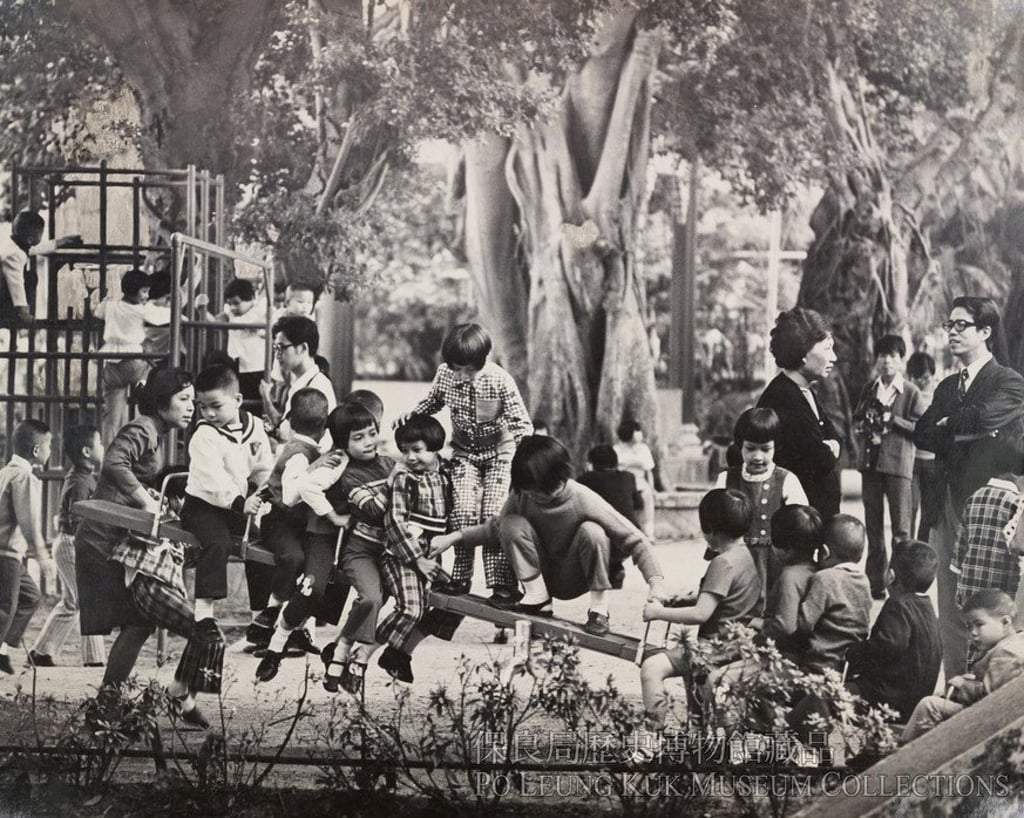The building is open to visitors keen to learn more about the organisation’s long history of protecting the young and innocent – the only out-of-bounds area being the children’s residential area on the second floor.

Enter the complex by passing through a green-roofed traditional Chinese paifang gate and the first thing you see is a play area. Children’s playgrounds started to appear in Hong Kong at the beginning of the 20th century, and space for play has always been an essential part of the Po Leung Kuk complex.
Painted white, the two-storey main building looks small in comparison to the towering luxury residential complex behind it.

Inside, the walls are filled with Chinese inscriptions written by famous calligraphers. The earliest are from the Qing dynasty.
At the centre of the building is the Kwan Ti hall, where the patron deity of the organisation is worshipped. The deep brown Kwan Ti altar, donated by a Chinese merchant in 1896, is one of the oldest items in the Po Leung Kuk building.
There is a museum on the ground floor with an extensive archive that tells the story of how the massive entity grew from a single petition.

In 1878, a group of elite Chinese submitted a petition to the British governor that advocated setting up a bureau named “Po Leung Kuk” to help women and children who had been abducted in China and forced into labour and prostitution in Hong Kong; po leung means to care for destitute children and women.
It was a time when Hong Kong was a hotbed of cross-border human trafficking. As the British colony became much wealthier than Qing dynasty China – which had been in decline since the early 1800s – many women were either kidnapped there or sold by their families to become mui tsai (maidservants) to wealthy families in Hong Kong. Others faced a grimmer fate, being sold into prostitution.
Many Chinese children also landed in Hong Kong, not only because they were abducted or sold, but because they were separated from their parents after getting lost or boarding the wrong ferry.

The colonial government accepted the petitioners’ suggestion. That same year Po Leung Kuk was founded, and the petitioners became directors of the bureau. With that they took on the task of investigating and dealing with kidnapping cases.
They personally interviewed the victims and used their own networks to help them contact and ultimately return to their families in China. Eventually, more detectives were hired through donations made by Hong Kong gentry and merchants.
Human trafficking continued to be a grave problem well into the 20th century. In 1922, the first meeting was held in the city to discuss ending the notorious practice.
In the earliest days, those rescued by Po Leung Kuk stayed at a site it operated in Sheung Wan, on the upper floors of Tung Wah Hospital. The number of residents continued to increase, and a decision was taken to build the headquarters at 66 Leighton Road, Causeway Bay.
Today the headquarters is often mistaken for an orphanage, but it is more like temporary accommodation for children who need help and care.

Their parents may be drug addicts or alcoholics, or in prison, according to Helena Pong, chairwoman of the Po Leung Kuk. “The Social Welfare Department asks us to take care of these children until the day their parents are fit to take care of them. Then, the children may return to their parents.”
The interior of the historic building is well kept and maintained. Portraits of Po Leung Kuk directors and major donors to the charity cover its walls.
The earliest portraits inside the Kwan Ti hall are from 1932 and are hand-painted on porcelain in black and white. Many of the subjects are wearing mandarin robes and hats. They are mostly men, other than four women – three Chinese and one Caucasian – who donated sums of money to build the headquarters.
A walk down the hallway feels like a journey through time, as hand-painted portraits give way to photos and the subjects’ clothes and hairstyles, and the portraits’ composition, change drastically.
One thing that has remained constant is the atmosphere of the place: it is a safe space for the young residents who have landed there under the most trying circumstances.

A photograph in Po Leung Kuk’s archive from 1978 shows children playing on a see-saw in the garden outside the headquarters. The young girls all have bowl haircuts and short fringes, while the boys have shaved heads.
Today’s young residents display a similar sense of timeless innocence, as they giggle and cast curious glances at visitors when they return to the 92-year-old building after school.
Pong mentions that in June a former resident, now in his 40s, visited the headquarters with his wife and children. He had spent some time in Po Leung Kuk’s care when he was very young, until he was adopted by a family in the United States. He is now a professor there.
“He remembered the way the metal beds were set up at the time,” Pong says. Former residents often come back to take part in events at the headquarters, such as talent shows staged by the current residents, she adds.

Po Leung Kuk currently operates more than 300 “service units”, including schools, healthcare centres, rehabilitation centres, old people’s homes, and funeral parlours. It continues to live up to its name.
And so it seems that as long as Po Leung Kuk exists, it will continue to provide Hongkongers with support, and its complex on Leighton Road will remain a safe space for children in need.

